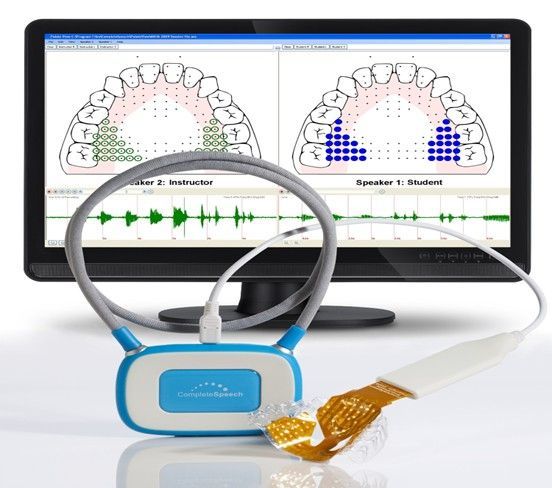Specialized Techniques and Tools
SmartPalate System (Pre-Orthodontic Treatment)
A palatometer to improve specific speech sounds through real-time powerful visual feedback. Most persistent articulation problems are resolved in as few as 20 sessions.
Prompt Therapy
PROMPT is an acronym for Prompts for Restructuring Oral Muscular Phonetic Targets. The technique is a tactile-kinesthetic approach that uses touch cues to a patient’s articulators (jaw, tongue, lips) to manually guide them through a targeted word, phrase or sentence. The technique develops motor control and the development of proper oral muscular movements, while eliminating unnecessary muscle movements, such as jaw sliding and inadequate lip rounding.
Augmentative Alternative Communication (AAC)
AAC uses a variety of techniques and tools, including picture communication boards, line drawings, speech-generating devices (SGDs), tangible objects, manual signs, gestures, and finger spelling, to help the individual express thoughts, wants and needs, feelings, and ideas.
Play Attention (for users ages 6–adult)
A virtual reality real-time powerful visual feedback systems built on NASA-proven technology the brain is “trained” to gain focus, improve concentration, and pay attention.

Interactive Metronome (IM)
A research-based assessment and treatment tool used in therapy to improve the neurological processes of motor planning, sequencing and processing. The IM program provides a structured, goal-oriented process that challenges the patient to synchronize a range of hand and foot exercises to a precise computer-generated reference tone heard through headphones. The participant attempts to match the rhythmic beat with repetitive motor actions. An auditory-visual guidance system provides immediate feedback measured in milliseconds, and a score is provided. (IM is proven to improve cognition, attention, focus, memory, speech/language, executive function, comprehension, as well as motor and sensor skills)
Forebrain is a revolutionary brain training device transforms speech, attention, and memory used to treat special education needs, dyslexia, speech difficulties, Auditory Processing Disorders, ADHD, Learning & Reading Difficulties, Autism Spectrum Disorder, Voice Quality, and Stuttering
Orofacial Myofunctional Therapy focuses on nasal breathing and appropriate resting postures of the tongue, lips, and jaw. Children as young as 4-years-old will benefit from orofacial myofunctional therapy. Starting young allows us to retrain the muscles and movement patterns to prevent ongoing and future problems related to eating, swallowing, breathing, jaw development, and patterns of dental eruption and alignment.
